Dec 26, 2017
TechnologyConfiguration Steps
Select the SAS Controller:

Ignore the foreign configration, hit cancel:

Display all of the disks:

Select one disk(1T-Disk):
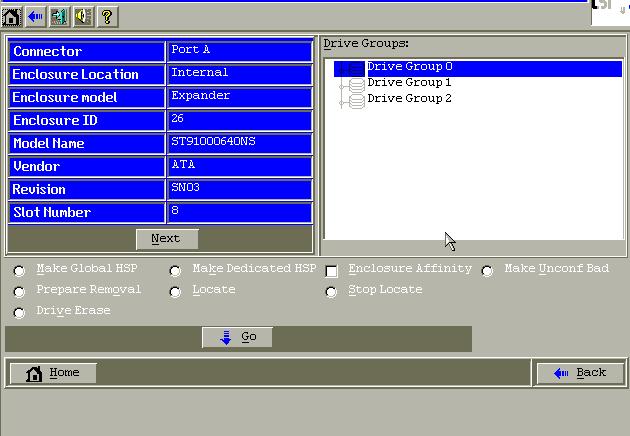
Click configuration wizard:

Select Configuration Method:

Configure a new disk:

Click “Accept DG” for accepting the configurations.
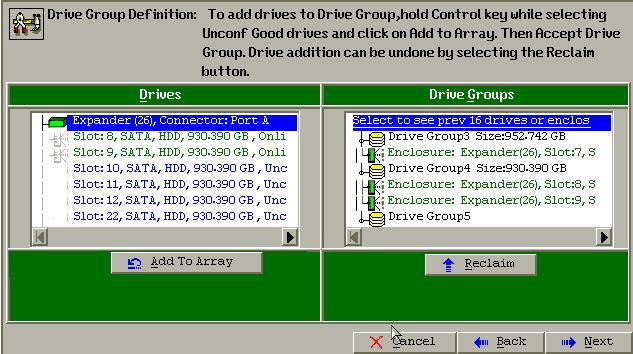
Ignore add Span:

Add to Span:
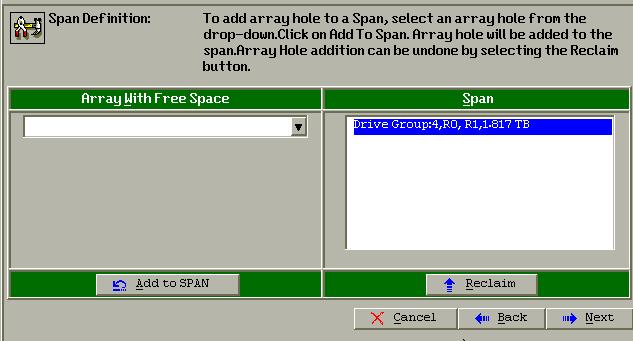


Now you add successfully.
Click Accept:
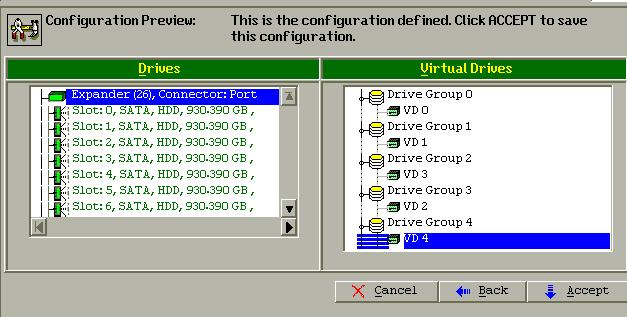
Click Save Configuration, and you will be asked to initialize the new virtual
driver, click yes.

Then save and reboot your system, your configuration will be done.
System
Install a new system under /dev/sde, then you could use following command for
setting the grub configuration:
# os-prober
# grub2-mkconfig -o /boot/grub2/grub.cfg
Then you could get your newly installed system working.
Dec 24, 2017
TechnologyAIM
To setup an wireless ap which could enable all of the equipment free to
internet.
Startup
Download the rpi image from:
http://downloads.raspberrypi.org/raspbian/images/raspbian-2017-12-01/2017-11-29-raspbian-stretch.zip
Then unzip this image file and write to sd card.
Plugin your sd card into your rpi board, startup. At the very beginning, you
have to enable the ssh via:
$ sudo systemctl enable ssh && sudo systemctl start ssh
Then you could login remotely using ssh, default username/password is
pi/raspberry.
Edit the sources.list and install some necessary packages:
$ sudo vim /etc/apt/sources.list
deb http://mirrors.aliyun.com/raspbian/raspbian/ stretch main non-free contrib
$ sudo apt-get update && sudo apt-get install -y vim
Enable the ip_forward via:
$ sudo vim /etc/sysctl.conf
net.ipv4.ip_forward=1
$ sudo systcl -p
Network Configuration
Configure the network via:
$ cat /etc/network/interfaces
# interfaces(5) file used by ifup(8) and ifdown(8)
# Please note that this file is written to be used with dhcpcd
# For static IP, consult /etc/dhcpcd.conf and 'man dhcpcd.conf'
# Include files from /etc/network/interfaces.d:
source-directory /etc/network/interfaces.d
##### To use hostapd you need do following.
auto wlan0
iface wlan0 inet static
address 10.0.70.1
netmask 255.255.255.0
auto eth0
iface eth0 inet static
address 192.168.0.15
netmask 255.255.255.0
gateway 192.168.0.1
Restart your network you will get the wlan0 as 10.0.70.1, while your wired
network acts as the 192.168.0.15 in ethernet.
dnsmasq and pdnsd
Configure the dnsmasq as the dhcpd server via:
# apt-get install dnsmasq
# vim /etc/dnsmasq.conf
port=9053
#配置监听地址
listen-address=127.0.0.1,10.0.70.1
#配置DHCP分配段
dhcp-range=10.0.70.50,10.0.70.150,12h
dhcp-option=6,192.168.0.15
While your dns was polluted via the fucking gfw, you have to use pdnsd for
getting the correct dns.
# apt-get install pdnsd
# vim /etc/pdnsd.conf
My pdnsd configuration file is listed as following:
// Read the pdnsd.conf(5) manpage for an explanation of the options.
/* Note: this file is overriden by automatic config files when
/etc/default/pdnsd AUTO_MODE is set and that
/usr/share/pdnsd/pdnsd-$AUTO_MODE.conf exists
*/
global {
perm_cache=4096;
cache_dir="/var/cache/pdnsd";
run_as="pdnsd";
server_ip = 192.168.0.15;
server_port=53;
status_ctl = on;
query_method=tcp_only;
neg_domain_pol = off;
paranoid = on;
par_queries = 1;
min_ttl = 6h;
max_ttl = 12h;
timeout = 10;
}
/* with status_ctl=on and resolvconf installed, this will work out from the box
this is the recommended setup for mobile machines */
server {
label = "routine";
ip = 223.5.5.5;
timeout = 5;
reject = 74.125.127.102,
74.125.155.102,
74.125.39.102,
74.125.39.113,
209.85.229.138,
128.121.126.139,
159.106.121.75,
169.132.13.103,
192.67.198.6,
202.106.1.2,
202.181.7.85,
203.161.230.171,
203.98.7.65,
207.12.88.98,
208.56.31.43,
209.145.54.50,
209.220.30.174,
209.36.73.33,
211.94.66.147,
213.169.251.35,
216.221.188.182,
216.234.179.13,
243.185.187.39,
37.61.54.158,
4.36.66.178,
46.82.174.68,
59.24.3.173,
64.33.88.161,
64.33.99.47,
64.66.163.251,
65.104.202.252,
65.160.219.113,
66.45.252.237,
69.55.52.253,
72.14.205.104,
72.14.205.99,
78.16.49.15,
8.7.198.45,
93.46.8.89,
37.61.54.158,
243.185.187.39,
190.93.247.4,
190.93.246.4,
190.93.245.4,
190.93.244.4,
65.49.2.178,
189.163.17.5,
23.89.5.60,
49.2.123.56,
54.76.135.1,
77.4.7.92,
118.5.49.6,
159.24.3.173,
188.5.4.96,
197.4.4.12,
220.250.64.24,
243.185.187.30,
249.129.46.48,
253.157.14.165;
reject_policy = fail;
exclude = ".google.com",
".cn",
".baidu.com",
".qq.com",
".gstatic.com",
".googleusercontent.com",
".googlepages.com",
".googlevideo.com",
".googlecode.com",
".googleapis.com",
".googlesource.com",
".googledrive.com",
".ggpht.com",
".youtube.com",
".youtu.be",
".ytimg.com",
".twitter.com",
".facebook.com",
".fastly.net",
".akamai.net",
".akamaiedge.net",
".akamaihd.net",
".edgesuite.net",
".edgekey.net";
}
server {
# Better setup dns server(DON'T USE PORT 53) on your own vps for faster proxying
label = "special";
ip = 208.67.222.222,208.67.220.220;
port = 5353;
proxy_only = on;
timeout = 5;
}
# Generated by resolvconf
server {
label=resolvconf;
ip=192.168.0.15;
}
# End of resolvconf
Enable the auto-start of pdnsd:
$ sudo vim /etc/default/pdnsd
START_DAEMON=yes
$ sudo systemctl enable pdnsd
$ sudo systemctl starrt pdnsd
Examine via:
$ sudo dig @192.168.0.15 www.youtube.com
ShadowSocks and RedSock2
Install shadowsocks via:
$ sudo pip install shadowsocks
$ sudo vim /etc/shadowsocks.conf
$ sudo vim /etc/rc.local
sslocal -c /etc/shadowsocks.conf -d start
Trouble-Shooting On sslocal:
$ vim /usr/local/lib/python2.7/dist-packages/shadowsocks/crypto/openssl.py
Comment all of the :
libcrypto.EVP_CIPHER_CTX_cleanup(self._ctx)
Changes to : libcrypto.EVP_CIPHER_CTX_reset(self._ctx)
# rm -f /usr/local/lib/python2.7/dist-packages/shadowsocks/crypto/openssl.pyc
Redsocks:
$ git clone https://github.com/semigodking/redsocks
$ cd redsocks
$ sudo apt-get install libevent-dev libssl-dev libpolarssl-dev
$ make USE_CRYPTO_POLARSSL=true
Configure the redsocks via:
$ vim redsocks.conf
base {
// debug: connection progress & client list on SIGUSR1
log_debug = off;
// info: start and end of client session
log_info = on;
/* possible `log' values are:
* stderr
* "file:/path/to/file"
* syslog:FACILITY facility is any of "daemon", "local0"..."local7"
*/
log = stderr;
// log = "file:/path/to/file";
// log = "syslog:local7";
// detach from console
daemon = on;
/* Change uid, gid and root directory, these options require root
* privilegies on startup.
* Note, your chroot may requre /etc/localtime if you write log to syslog.
* Log is opened before chroot & uid changing.
* Debian, Ubuntu and some other distributions use `nogroup` instead of
* `nobody`, so change it according to your system if you want redsocks
* to drop root privileges.
*/
// user = nobody;
// group = nobody;
// chroot = "/var/chroot";
/* possible `redirector' values are:
* iptables - for Linux
* ipf - for FreeBSD
* pf - for OpenBSD
* generic - some generic redirector that MAY work
*/
redirector = iptables;
/* Override per-socket values for TCP_KEEPIDLE, TCP_KEEPCNT,
* and TCP_KEEPINTVL. see man 7 tcp for details.
* `redsocks' relies on SO_KEEPALIVE option heavily. */
//tcp_keepalive_time = 0;
//tcp_keepalive_probes = 0;
//tcp_keepalive_intvl = 0;
}
redsocks {
/* `local_ip' defaults to 127.0.0.1 for security reasons,
* use 0.0.0.0 if you want to listen on every interface.
* `local_*' are used as port to redirect to.
*/
local_ip = 0.0.0.0;
local_port = 12345;
// listen() queue length. Default value is SOMAXCONN and it should be
// good enough for most of us.
listenq = 128; // SOMAXCONN equals 128 on my Linux box.
// `max_accept_backoff` is a delay to retry `accept()` after accept
// failure (e.g. due to lack of file descriptors). It's measured in
// milliseconds and maximal value is 65535. `min_accept_backoff` is
// used as initial backoff value and as a damper for `accept() after
// close()` logic.
// min_accept_backoff = 100;
// max_accept_backoff = 60000;
// `ip' and `port' are IP and tcp-port of proxy-server
// You can also use hostname instead of IP, only one (random)
// address of multihomed host will be used.
// The two fields are meaningless when proxy type is 'direct'.
ip = 127.0.0.1;
port = 1080;
// known types: socks4, socks5, http-connect, http-relay
// New types: direct, shadowsocks, https-connect
type = socks5;
// Specify interface for outgoing connections.
// This is useful when you have multiple connections to
// internet or when you have VPN connections.
// interface = tun0;
// Change this parameter to 1 if you want auto proxy feature.
// When autoproxy is set to non-zero, the connection to target
// will be made directly first. If direct connection to target
// fails for timeout/connection refuse, redsocks will try to
// connect to target via the proxy.
autoproxy = 0;
// timeout is meaningful when 'autoproxy' is non-zero.
// It specified timeout value when trying to connect to destination
// directly. Default is 10 seconds. When it is set to 0, default
// timeout value will be used.
timeout = 10;
// login = "foobar";// field 'login' is reused as encryption
// method of shadowsocks
// password = "baz";
}
//*redudp {
//* // `local_ip' should not be 0.0.0.0 as it's also used for outgoing
//* // packets that are sent as replies - and it should be fixed
//* // if we want NAT to work properly.
//* local_ip = 127.0.0.1;
//* local_port = 10053;
//*
//* // `ip' and `port' of socks5 proxy server.
//* ip = 10.0.0.1;
//* port = 1080;
//* login = username;// field 'login' is reused as encryption
//* // method of shadowsocks
//* password = pazzw0rd;
//*
//* // know types: socks5, shadowsocks
//* type = socks5;
//*
//* // redsocks knows about two options while redirecting UDP packets at
//* // linux: TPROXY and REDIRECT. TPROXY requires more complex routing
//* // configuration and fresh kernel (>= 2.6.37 according to squid
//* // developers[1]) but has hack-free way to get original destination
//* // address, REDIRECT is easier to configure, but requires `dest_ip` and
//* // `dest_port` to be set, limiting packet redirection to single
//* // destination.
//* // [1] http://wiki.squid-cache.org/Features/Tproxy4
//* dest_ip = 8.8.8.8;
//* dest_port = 53;
//*
//* // Do not set it large if this section is for DNS requests. Otherwise,
//* // you may encounter out of file descriptor problem. For DNS requests,
//* // 10s is adequate.
//* udp_timeout = 30;
//* udp_timeout_stream = 180;
//*}
//*
//*tcpdns {
//* // Transform UDP DNS requests into TCP DNS requests.
//* // You can also redirect connections to external TCP DNS server to
//* // REDSOCKS transparent proxy via iptables.
//* //local_ip = 192.168.1.1; // Local server to act as DNS server
//* //local_port = 1053; // UDP port to receive UDP DNS requests
//* //tcpdns1 = 8.8.4.4; // DNS server that supports TCP DNS requests
//* //tcpdns1_port = 53; // DNS server port, default 53
//* //tcpdns2 = 8.8.8.8; // DNS server that supports TCP DNS requests
//* //tcpdns2_port = 53; // DNS server port, default 53
//* //timeout = 4; // Timeout value for TCP DNS requests
//* local_ip=127.0.0.1;
//* local_port=5300;
//*}
autoproxy {
// Specify interface for outgoing connections.
// This is useful when you have multiple connections to
// internet or when you have VPN connections.
// interface = wlan0;
no_quick_check_seconds = 60; // Directly relay traffic to proxy if an IP
// is found blocked in cache and it has been
// added into cache no earlier than this
// specified number of seconds.
// Set it to 0 if you do not want to perform
// quick check when an IP is found in blocked
// IP cache, thus the connection will be
// redirected to proxy immediately.
quick_connect_timeout = 3; // Timeout value when performing quick
// connection check if an IP is found blocked
// in cache.
}
ipcache {
// Configure IP cache
cache_size = 4; // Maximum number of IP's in 1K.
stale_time = 900; // Seconds to stale an IP in cache since it is added
// into cahce.
// Set it to 0 to disable cache stale.
port_check = 1; // Whether to distinguish port number in address
cache_file = "/tmp/ipcache.txt"; // File used to store blocked IP's in cache.
autosave_interval = 3600; // Interval for saving ip cache into file.
// Set it to 0 to disable autosave.
// When autosave_interval and stale_time are both 0, IP cache behaves like
// a static blacklist.
}
// you can add more `redsocks' and `redudp' sections if you need.
Now you could add following lines into your /etc/rc.local file to enable redsocks
startup at the system boot:
$ sudo vim /etc/rc.local
$ /home/pi/redsocks/redsocks2 -c /home/pi/redsocks/redsocks.conf
hostapd
Setting hostapd for letting the wlan0 as an AP:
$ sudo apt-get install -y hostapd
$ vim /etc/hostapd/hostapd.conf
interface=wlan0
hw_mode=g
channel=10
ieee80211d=1
country_code=CN
ieee80211n=1
wmm_enabled=1
ssid=sssremote
auth_algs=1
wpa=2
wpa_key_mgmt=WPA-PSK
rsn_pairwise=CCMP
wpa_passphrase=xxxxxxxxxxx
$ sudo systemctl enable hostapd
$ sudo systemctl start hostapd
Or if you couldnot enable and start the hostpad via systemd, simply use the
following configuration:
$ sudo vim /etc/default/hostapd
Change:
#DAEMON_CONF=""
to
DAEMON_CONF="/etc/hostapd/hostapd.conf"
Check the DAEMON_OPTS="" is preceded by a #, so is #DAEMON_OPTS=""
And save.
Then your hostapd will start at the systemboot.
iptables rules
Use iptables-persistent for saving the rules:
$ sudo apt-get install -y iptables-persistent
$ sudo service netfilter-persistent save
$ sudo service netfilter-persistent rerload
Add following rules:
$ sudo iptables -t nat -A POSTROUTING -o wlan0 -j MASQUERADE
$ sudo iptables -t nat -N SHADOWSOCKS
$ sudo iptables -t nat -A SHADOWSOCKS -d $server_IP -j RETURN
$ sudo iptables -t nat -A SHADOWSOCKS -d 0.0.0.0/8 -j RETURN
$ sudo iptables -t nat -A SHADOWSOCKS -d 10.0.0.0/8 -j RETURN
$ sudo iptables -t nat -A SHADOWSOCKS -d 127.0.0.0/8 -j RETURN
$ sudo iptables -t nat -A SHADOWSOCKS -d 169.254.0.0/16 -j RETURN
$ sudo iptables -t nat -A SHADOWSOCKS -d 172.16.0.0/12 -j RETURN
$ sudo iptables -t nat -A SHADOWSOCKS -d 192.168.0.0/16 -j RETURN
$ sudo iptables -t nat -A SHADOWSOCKS -d 224.0.0.0/4 -j RETURN
$ sudo iptables -t nat -A SHADOWSOCKS -d 240.0.0.0/4 -j RETURN
$ sudo iptables -t nat -A SHADOWSOCKS -p tcp -j REDIRECT --to-ports 12345
$ sudo iptables -t nat -A OUTPUT -p tcp -j SHADOWSOCKS
$ sudo iptables -t nat -A PREROUTING -p tcp -j SHADOWSOCKS
Save the rules via:
$ sudo service netfilter-persistent save
Add system-reboot rules:
$ sudo vim /etc/rc.local
iptables-restore < /etc/iptables/rules.v4
Now reboot your raspberryPi, you will get a free wifi ap.
Dec 18, 2017
TechnologyAIM
To set up an free wireless solution working for WebDuino.
Because I located in china mainland, while our internet were forbidden by
government(Fuck GFW!), so I have to find another way for accross the firewall
and let WebDuino fetch back its updates.
Hardware Environment
Laptop.
Wireless dongle(Fast)
Bus 001 Device 002: ID 0bda:8179 Realtek Semiconductor Corp. RTL8188EUS 802.11n Wireless Network Adapter
VirtualMachine
I set a virtual machine which runs in virtualbox. First I thought
configuration via gui would be easier, but later I found it’s even inpossible
to use the gui configuration tools to let my usb wireless card acts as an ap.
Later I will use an ubuntu 32-bit server(i386) for setting up this wireless
ap.
To specify usb wireless dongle to virtualbox’s vm(Ubuntu16.04), do following:
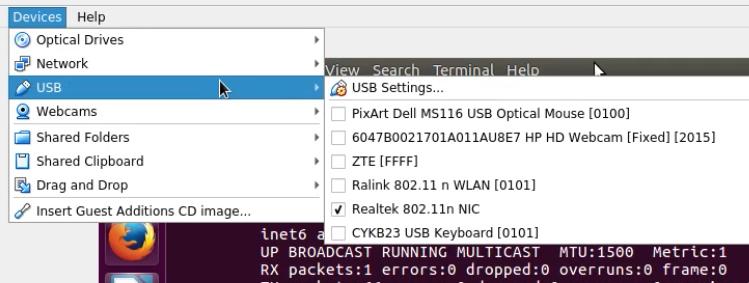
Then in your vm you will see the attached usb dongle.
System Configuration
Enable naming
If you didn’t specify the naming, Ubuntu16.04(or later than Ubuntu12.04) won’t
recognize your ethernet card or wireless card as “eth0” or “wlan0”, so you
have to changint then in grub parameters:
If you don’t do this step, your wireless card will be recognized as something
like “wlx000e8e22xxxxxx”, this will makes your configuration a little bit
confusing.
# vim /etc/default/grub
GRUB_CMDLINE_LINUX="net.ifnames=0 biosdevname=0"
# sudo update-grub
# sudo reboot
After rebooting, your wireless card will be recoginzed as “wlan0”.
Don’t forget to update your /etc/network/interface, change from “enp0s” to
“eth”.
8188eu hostapd
The system’s default hostapd won’t be used, we have to use 8188eu’s own
hostapd for working, the steps are listed as following:
$ sudo apt-get autoremove hostapd
$ wget https://github.com/jenssegers/RTL8188-hostapd/archive/v2.0.tar.gz
$ tar -zxvf v2.0.tar.gz
$ cd RTL8188-hostapd-2.0/hostapd
$ sudo make
$ sudo make install
$ sudo systemctl enable hostapd
$ sudo service hostapd restart
If you didn’t see your hostapd working, simply reboot your machine, and check
again.
8188eu hostapd configuration
Your hostapd configuration file is located in /etc/hostapd/hostapd.conf,
following are the configuration example:
interface=wlan0
ssid=sosowifi
channel=1
#bridge=br0
# WPA and WPA2 configuration
macaddr_acl=0
auth_algs=1
ignore_broadcast_ssid=0
wpa=3
wpa_passphrase=XXXXXXXXXXXXXXXXX
wpa_key_mgmt=WPA-PSK
wpa_pairwise=TKIP
rsn_pairwise=CCMP
# Hardware configuration
driver=rtl871xdrv
ieee80211n=1
hw_mode=g
device_name=RTL8192CU
manufacturer=Realtek
Check the status via:
$ sudo systemctl status hostapd
● hostapd.service - LSB: Advanced IEEE 802.11 management daemon
Loaded: loaded (/etc/init.d/hostapd; bad; vendor preset: enabled)
Active: active (running) since 一 2017-12-18 15:00:02 CST; 27min ago
Docs: man:systemd-sysv-generator(8)
Process: 1502 ExecStart=/etc/init.d/hostapd start (code=exited, status=0/SUCCESS)
Tasks: 1 (limit: 512)
CGroup: /system.slice/hostapd.service
└─1525 /usr/local/bin/hostapd -B -P /var/run/hostapd.pid /etc/hostapd/hostapd.conf
ra2770 configuration
Edit the /etc/hostapd/hostapd.conf file listed as following:
# RT2770
interface=wlan0
driver=nl80211
ssid=my_ap
hw_mode=g
channel=6
macaddr_acl=0
auth_algs=1
ignore_broadcast_ssid=0
wpa=3
wpa_passphrase=xxxxxxxxxxxxxxxxxxxx
wpa_key_mgmt=WPA-PSK
wpa_pairwise=TKIP
rsn_pairwise=CCMP
wlan0 configuration
Setup the wlan0 ip address via following:
# vim /etc/network/interface
# wireless wlan0
allow-hotplug wlan0
iface wlan0 inet static
address 10.0.70.1
netmask 255.255.255.0
We set wlan0’s ip address as the gateway for our wifi-network.
dhcpcd
We have to use dhcpd for assiging the ip address to connected.
$ sudo apt-get install isc-dhcp-server
$ sudo vim /etc/dhcp/dhcpd.conf
ddns-update-style none;
ignore client-updates;
authoritative;
option local-wpad code 252 = text;
subnet 10.0.70.0 netmask 255.255.255.0 {
# --- default gateway
option routers 10.0.70.1;
# --- Netmask
option subnet-mask 255.255.255.0;
# --- Broadcast Address
option broadcast-address 10.0.70.255;
# --- Domain name servers, tells the clients which DNS servers to use.
option domain-name-servers
10.0.70.1, 8.8.8.8, 8.8.4.4;
option time-offset 0;
range 10.0.70.3 10.0.70.13;
default-lease-time 1209600;
max-lease-time 1814400;
}
We won’t add dhcpd for auto-startup, because we don’t want person to connect
to our ap at the very beginning time.
IP Forwarding
We enable the ip forwarding of the kernel and setup the postrouting for
iptables:
$ sudo iptables -t nat -A POSTROUTING -s 10.0.70.0/24 ! -d 10.0.70.0/24 -j MASQUERADE
$ sudo dhcpd wlan0
$ sudo bash
# echo 1 > /proc/sys/net/ipv4/ip_forward
Now you should be able to access the network.
Trouble-Shooting
If you use virtualbox’s redirect usb. you will encounter several problems. Try
to change from virtualbox to virt-manager:
# VBoxManage clonehd --format RAW UbuntuServer.vdi UbuntuServer.img
# qemu-img convert -f raw UbuntuServer.img -O qcow2 UbuntuServer.qcow2
Now create a new virtual machine in virt-manager, you will find your wifi
sharing become stable.
Redirect the usb device via spice driver.
clean dns
Install dnsmasq:
$ sudo apt-get install -y dnsmasq
Configure dnsmasq to listen on 9053 port:
$ sudo service dnsmasq stop
$ sudo netstat -anp |grep 53
unix 2 [ ACC ] STREAM LISTENING 11653 1/init /run/lvm/lvmpolld.socket
unix 3 [ ] STREAM CONNECTED 10534 441/lvmetad
unix 3 [ ] STREAM CONNECTED 14553 977/accounts-daemon
unix 2 [ ] DGRAM 29853 5893/sudo
$ sudo vim /etc/dnsmasq.conf
port=9053
$ sudo service dnsmasq restart
$ sudo netstat -anp |grep 53
tcp 0 0 0.0.0.0:9053 0.0.0.0:* LISTEN 5943/dnsmasq
tcp6 0 0 :::9053 :::* LISTEN 5943/dnsmasq
udp 0 0 0.0.0.0:9053 0.0.0.0:* 5943/dnsmasq
udp6 0 0 :::9053 :::* 5943/dnsmasq
unix 2 [ ACC ] STREAM LISTENING 11653 1/init /run/lvm/lvmpolld.socket
unix 3 [ ] STREAM CONNECTED 10534 441/lvmetad
unix 3 [ ] STREAM CONNECTED 14553 977/accounts-daemon
Configure resolv.conf to nameserver 223.5.5.5 then install pdnsd:
$ sudo apt-get install -y pdnsd
Configure as manual:
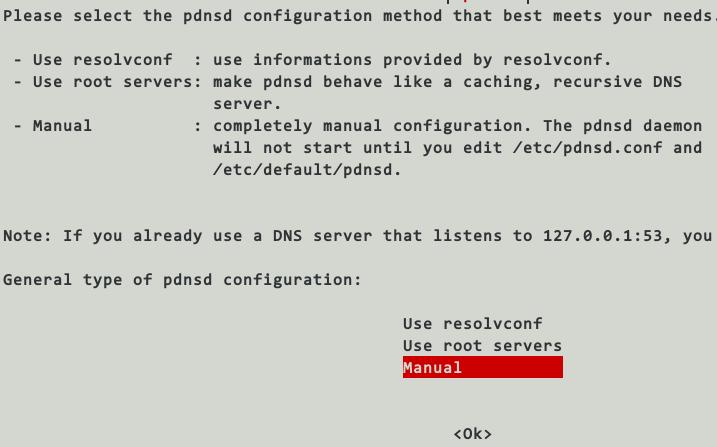
Configure the pdnsd configuration as following:
// Read the pdnsd.conf(5) manpage for an explanation of the options.
/* Note: this file is overriden by automatic config files when
/etc/default/pdnsd AUTO_MODE is set and that
/usr/share/pdnsd/pdnsd-$AUTO_MODE.conf exists
*/
global {
perm_cache=4096;
cache_dir="/var/cache/pdnsd";
run_as="pdnsd";
server_ip = 127.0.0.1;
server_port=53;
status_ctl = on;
query_method=tcp_only;
neg_domain_pol = off;
paranoid = on;
par_queries = 1;
min_ttl = 6h;
max_ttl = 12h;
timeout = 10;
}
/* with status_ctl=on and resolvconf installed, this will work out from the box
this is the recommended setup for mobile machines */
server {
label = "routine";
ip = 223.5.5.5;
timeout = 5;
reject = 74.125.127.102,
74.125.155.102,
74.125.39.102,
74.125.39.113,
209.85.229.138,
128.121.126.139,
159.106.121.75,
169.132.13.103,
192.67.198.6,
202.106.1.2,
202.181.7.85,
203.161.230.171,
203.98.7.65,
207.12.88.98,
208.56.31.43,
209.145.54.50,
209.220.30.174,
209.36.73.33,
211.94.66.147,
213.169.251.35,
216.221.188.182,
216.234.179.13,
243.185.187.39,
37.61.54.158,
4.36.66.178,
46.82.174.68,
59.24.3.173,
64.33.88.161,
64.33.99.47,
64.66.163.251,
65.104.202.252,
65.160.219.113,
66.45.252.237,
69.55.52.253,
72.14.205.104,
72.14.205.99,
78.16.49.15,
8.7.198.45,
93.46.8.89,
37.61.54.158,
243.185.187.39,
190.93.247.4,
190.93.246.4,
190.93.245.4,
190.93.244.4,
65.49.2.178,
189.163.17.5,
23.89.5.60,
49.2.123.56,
54.76.135.1,
77.4.7.92,
118.5.49.6,
159.24.3.173,
188.5.4.96,
197.4.4.12,
220.250.64.24,
243.185.187.30,
249.129.46.48,
253.157.14.165;
reject_policy = fail;
exclude = ".google.com",
".cn",
".baidu.com",
".qq.com",
".gstatic.com",
".googleusercontent.com",
".googlepages.com",
".googlevideo.com",
".googlecode.com",
".googleapis.com",
".googlesource.com",
".googledrive.com",
".ggpht.com",
".youtube.com",
".youtu.be",
".ytimg.com",
".twitter.com",
".facebook.com",
".fastly.net",
".akamai.net",
".akamaiedge.net",
".akamaihd.net",
".edgesuite.net",
".edgekey.net";
}
server {
# Better setup dns server(DON'T USE PORT 53) on your own vps for faster proxying
label = "special";
ip = 208.67.222.222,208.67.220.220;
port = 5353;
proxy_only = on;
timeout = 5;
}
Configure the daemon:
$ sudo vim /etc/default/pdnsd
.....
START_DAEMON=yes
.....
$ sudo /etc/init.d/pdnsd restart
Examine the result of our pdnsd:
# dig @127.0.0.1 -p 53 www.youtube.com
; <<>> DiG 9.10.3-P4-Ubuntu <<>> @127.0.0.1 -p 53 www.youtube.com
; (1 server found)
;; global options: +cmd
;; Got answer:
;; ->>HEADER<<- opcode: QUERY, status: NOERROR, id: 33429
;; flags: qr rd ra; QUERY: 1, ANSWER: 8, AUTHORITY: 0, ADDITIONAL: 1
;; OPT PSEUDOSECTION:
; EDNS: version: 0, flags:; udp: 1024
;; QUESTION SECTION:
;www.youtube.com. IN A
;; ANSWER SECTION:
www.youtube.com. 43200 IN CNAME youtube-ui.l.google.com.
youtube-ui.l.google.com. 21600 IN CNAME youtube-ui-china.l.google.com.
youtube-ui-china.l.google.com. 21600 IN A 74.125.203.101
youtube-ui-china.l.google.com. 21600 IN A 74.125.203.102
youtube-ui-china.l.google.com. 21600 IN A 74.125.203.100
youtube-ui-china.l.google.com. 21600 IN A 74.125.203.139
youtube-ui-china.l.google.com. 21600 IN A 74.125.203.113
youtube-ui-china.l.google.com. 21600 IN A 74.125.203.138
;; Query time: 280 msec
;; SERVER: 127.0.0.1#53(127.0.0.1)
;; WHEN: Mon Dec 18 22:10:02 CST 2017
;; MSG SIZE rcvd: 205
shadowsocks
Install and configure shadowsocks via following command:
$ sudo apt-get install -y python-pip
$ sudo pip install shadowsocks
$ sudo pip install --upgrade pip
$ sudo vim /etc/shadowsocks/config.json
xxxxxxxxxxxxxxxx
$ sslocal -c /etc/shadowsocks/config.json
redsocks
Get the source code via:
$ git clone https://github.com/semigodking/redsocks
$ sudo apt-get -y install libevent-dev libssl-dev
$ cd redsocks
$ make
After make, you will find the executable file named redsocks2 under the
folder.
Configure the redsocks(diff file listed as following):
dash@ubuntu:~/redsocks$ cp redsocks.conf.example redsocks.conf
dash@ubuntu:~/redsocks$ vim redsocks.conf
dash@ubuntu:~/redsocks$ diff redsocks.conf redsocks.conf.example
18c18
< daemon = on;
---
> daemon = off;
53c53
< local_ip = 0.0.0.0;
---
> local_ip = 127.0.0.1;
58c58
< listenq = 128; // SOMAXCONN equals 128 on my Linux box.
---
> // listenq = 128; // SOMAXCONN equals 128 on my Linux box.
72c72
< ip = 127.0.0.1;
---
> ip = example.org;
101,147c101,147
< //redudp {
< // // `local_ip' should not be 0.0.0.0 as it's also used for outgoing
< // // packets that are sent as replies - and it should be fixed
< // // if we want NAT to work properly.
< // local_ip = 127.0.0.1;
< // local_port = 10053;
< //
< // // `ip' and `port' of socks5 proxy server.
< // ip = 10.0.0.1;
< // port = 1080;
< // login = username;// field 'login' is reused as encryption
< // // method of shadowsocks
< // password = pazzw0rd;
< //
< // // know types: socks5, shadowsocks
< // type = socks5;
< //
< // // redsocks knows about two options while redirecting UDP packets at
< // // linux: TPROXY and REDIRECT. TPROXY requires more complex routing
< // // configuration and fresh kernel (>= 2.6.37 according to squid
< // // developers[1]) but has hack-free way to get original destination
< // // address, REDIRECT is easier to configure, but requires `dest_ip` and
< // // `dest_port` to be set, limiting packet redirection to single
< // // destination.
< // // [1] http://wiki.squid-cache.org/Features/Tproxy4
< // dest_ip = 8.8.8.8;
< // dest_port = 53;
< //
< // // Do not set it large if this section is for DNS requests. Otherwise,
< // // you may encounter out of file descriptor problem. For DNS requests,
< // // 10s is adequate.
< // udp_timeout = 30;
< // // udp_timeout_stream = 180;
< //}
< //
< //tcpdns {
< // // Transform UDP DNS requests into TCP DNS requests.
< // // You can also redirect connections to external TCP DNS server to
< // // REDSOCKS transparent proxy via iptables.
< // local_ip = 192.168.1.1; // Local server to act as DNS server
< // local_port = 1053; // UDP port to receive UDP DNS requests
< // tcpdns1 = 8.8.4.4; // DNS server that supports TCP DNS requests
< // tcpdns1_port = 53; // DNS server port, default 53
< // tcpdns2 = 8.8.8.8; // DNS server that supports TCP DNS requests
< // tcpdns2_port = 53; // DNS server port, default 53
< // timeout = 4; // Timeout value for TCP DNS requests
< //}
---
> redudp {
> // `local_ip' should not be 0.0.0.0 as it's also used for outgoing
> // packets that are sent as replies - and it should be fixed
> // if we want NAT to work properly.
> local_ip = 127.0.0.1;
> local_port = 10053;
>
> // `ip' and `port' of socks5 proxy server.
> ip = 10.0.0.1;
> port = 1080;
> login = username;// field 'login' is reused as encryption
> // method of shadowsocks
> password = pazzw0rd;
>
> // know types: socks5, shadowsocks
> type = socks5;
>
> // redsocks knows about two options while redirecting UDP packets at
> // linux: TPROXY and REDIRECT. TPROXY requires more complex routing
> // configuration and fresh kernel (>= 2.6.37 according to squid
> // developers[1]) but has hack-free way to get original destination
> // address, REDIRECT is easier to configure, but requires `dest_ip` and
> // `dest_port` to be set, limiting packet redirection to single
> // destination.
> // [1] http://wiki.squid-cache.org/Features/Tproxy4
> dest_ip = 8.8.8.8;
> dest_port = 53;
>
> // Do not set it large if this section is for DNS requests. Otherwise,
> // you may encounter out of file descriptor problem. For DNS requests,
> // 10s is adequate.
> udp_timeout = 30;
> // udp_timeout_stream = 180;
> }
>
> tcpdns {
> // Transform UDP DNS requests into TCP DNS requests.
> // You can also redirect connections to external TCP DNS server to
> // REDSOCKS transparent proxy via iptables.
> local_ip = 192.168.1.1; // Local server to act as DNS server
> local_port = 1053; // UDP port to receive UDP DNS requests
> tcpdns1 = 8.8.4.4; // DNS server that supports TCP DNS requests
> tcpdns1_port = 53; // DNS server port, default 53
> tcpdns2 = 8.8.8.8; // DNS server that supports TCP DNS requests
> tcpdns2_port = 53; // DNS server port, default 53
> timeout = 4; // Timeout value for TCP DNS requests
> }
usb network sharing
ZTE cellphone for sharing its connection:
auto usb0-
allow-hotplug usb0
iface usb0 inet static
address 192.168.42.75
netmask 255.255.255.0
up route add default gw 192.168.42.129 dev usb0
down route del default gw 192.168.42.129 dev usb0
Dec 14, 2017
TechnologySteps
Create ESXI vm machine:
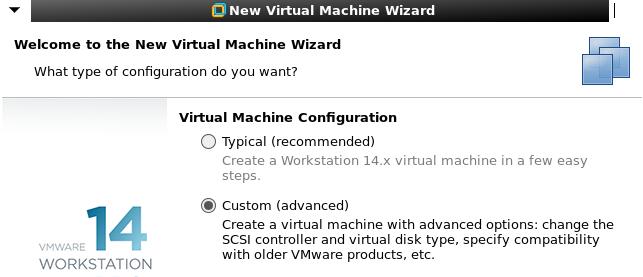
Typical setting:
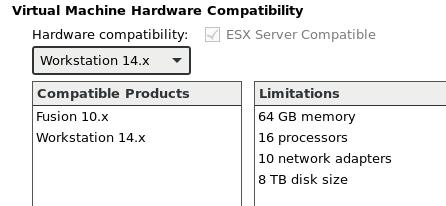
I will install the operating system later:
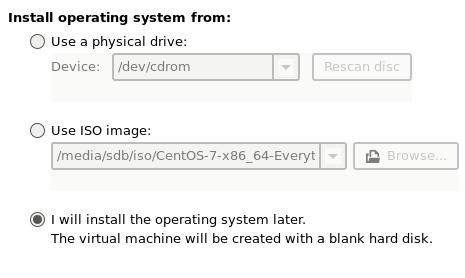
Select guest operating system(Select ESXi 6.0):
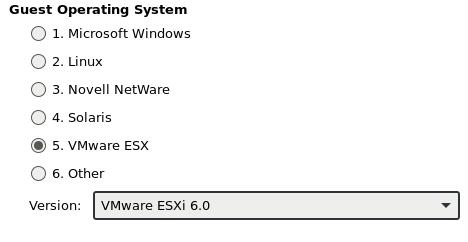
Location:

Select 8 core:
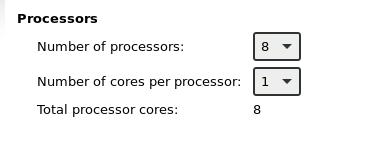
32GB Memory:
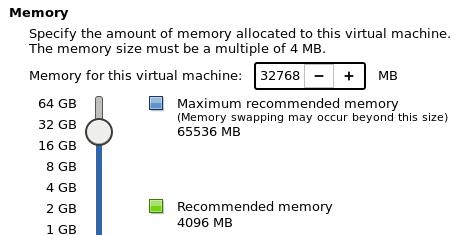
Use NAT:
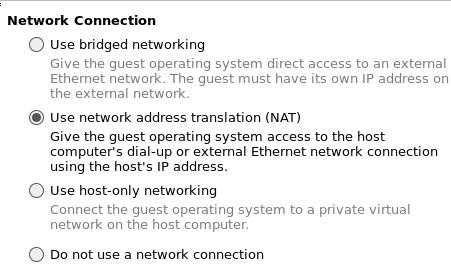
LSI logic:
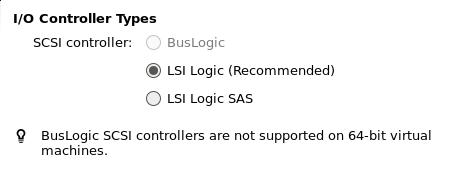
scsi:

Create new, 20GB, single file. name it:

Customize, add an 280 GB Disk, also select the iso file.Click for
installation.
Dec 13, 2017
TechnologyParameter
See Images:
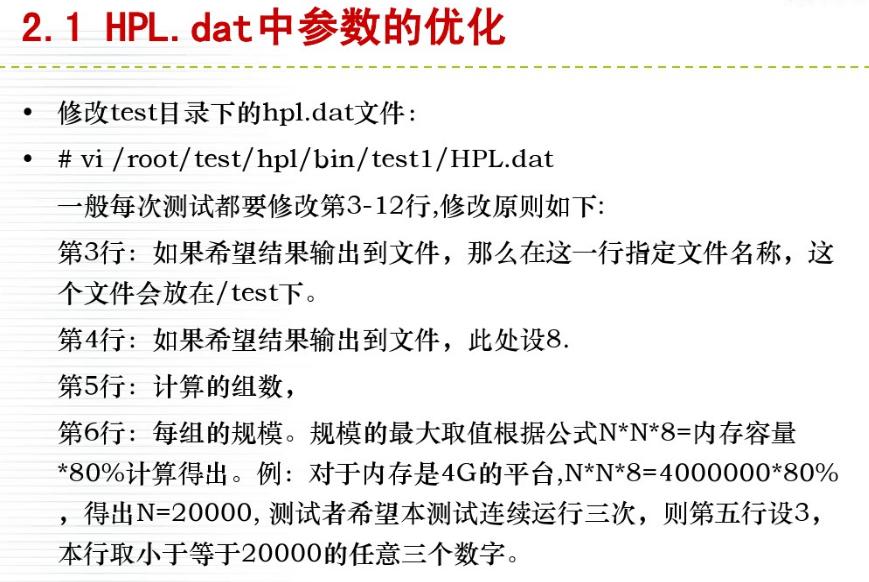

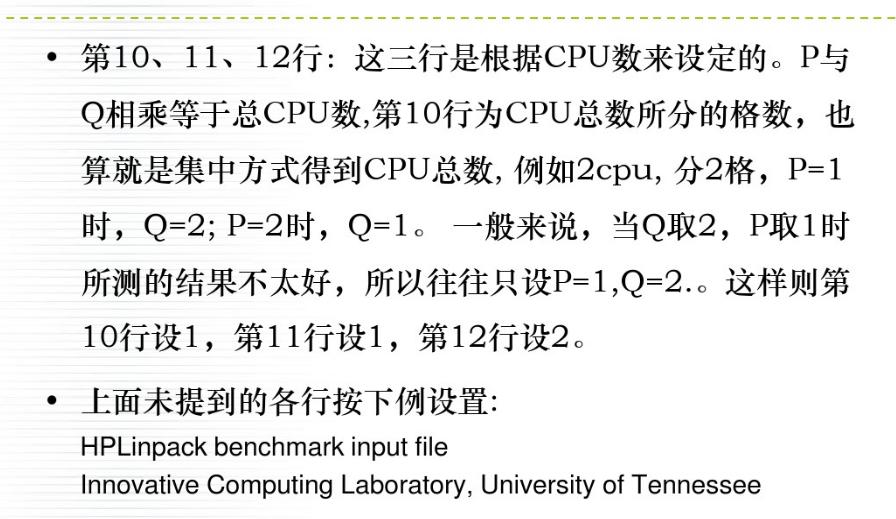
Reference Website
HOW DO I TUNE MY HPL.DAT FILE?:
http://www.advancedclustering.com/act_kb/tune-hpl-dat-file/
The testing is pretty long time-consuming…..






























